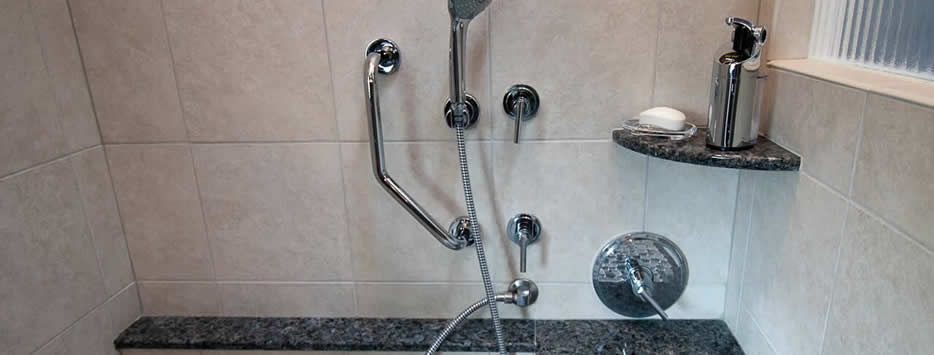
During the design process, many of our customers have asked, “What is Universal Design ?” Hopefully, this resource will help you understand how using it to remodel your home can make all the difference in the world for your family.
You see, we use Universal Design in some way in all of the accessible remodeling we do for our customers in Cincinnati and Loveland. It is an idea that is not understood by everyone, but it can significantly affect how much you enjoy the remodeling you have done to your home.
Universal design is the process of creating products (devices, environments, systems, and processes) which are usable by people with the widest possible range of abilities, operating within the widest possible range of situations (environments, conditions, and circumstances).
~ Trace Center, College of Engineering, University of Wisconsin-Madison
So, what does that mean? It’s essentially creating something that can be used by nearly everyone, regardless of abilities, age, situation, etc.
What is Universal Design in remodeling?
When we say we use Universal Design principles in our work, it means we’re applying our knowledge and experience in home remodeling, space planning, accessibility and Universal Design to create a space that is easy to use by the most amount of people. But, specifically, you and your family.
What that means for you is that your new kitchen, bathroom, laundry room or other area in your home are a joy to be in and use … because they work for you.
It may still not make perfect sense. But, after you read the next section, we think you’ll see how important it is.
7 Principles of Universal Design
The following principles of Universal Design were developed by North Carolina State University and are what is commonly meant when someone is talking about using Universal Design.
PRINCIPLE ONE: Equitable Use
The design is useful and marketable to people with diverse abilities.Guidelines:
1a. Provide the same means of use for all users: identical whenever possible; equivalent when not.
1b. Avoid segregating or stigmatizing any users.
1c. Provisions for privacy, security, and safety should be equally available to all users.
1d. Make the design appealing to all users.PRINCIPLE TWO: Flexibility in Use
The design accommodates a wide range of individual preferences and abilities.Guidelines:
2a. Provide choice in methods of use.
2b. Accommodate right- or left-handed access and use.
2c. Facilitate the user’s accuracy and precision.
2d. Provide adaptability to the user’s pace.PRINCIPLE THREE: Simple and Intuitive Use
Use of the design is easy to understand, regardless of the user’s experience, knowledge, language skills, or current concentration level.Guidelines:
3a. Eliminate unnecessary complexity.
3b. Be consistent with user expectations and intuition.
3c. Accommodate a wide range of literacy and language skills.
3d. Arrange information consistent with its importance.
3e. Provide effective prompting and feedback during and after task completion.PRINCIPLE FOUR: Perceptible Information
The design communicates necessary information effectively to the user, regardless of ambient conditions or the user’s sensory abilities.Guidelines:
4a. Use different modes (pictorial, verbal, tactile) for redundant presentation of essential information.
4b. Provide adequate contrast between essential information and its surroundings.
4c. Maximize “legibility” of essential information.
4d. Differentiate elements in ways that can be described (i.e., make it easy to give instructions or directions).
4e. Provide compatibility with a variety of techniques or devices used by people with sensory limitations.PRINCIPLE FIVE: Tolerance for Error
The design minimizes hazards and the adverse consequences of accidental or unintended actions.Guidelines:
5a. Arrange elements to minimize hazards and errors: most used elements, most accessible; hazardous elements eliminated, isolated, or shielded.
5b. Provide warnings of hazards and errors.
5c. Provide fail safe features.
5d. Discourage unconscious action in tasks that require vigilance.PRINCIPLE SIX: Low Physical Effort
The design can be used efficiently and comfortably and with a minimum of fatigue.Guidelines:
6a. Allow user to maintain a neutral body position.
6b. Use reasonable operating forces.
6c. Minimize repetitive actions.
6d. Minimize sustained physical effort.PRINCIPLE SEVEN: Size and Space for Approach and Use
Appropriate size and space is provided for approach, reach, manipulation, and use regardless of user’s body size, posture, or mobility.Guidelines:
7a. Provide a clear line of sight to important elements for any seated or standing user.
7b. Make reach to all components comfortable for any seated or standing user.
7c. Accommodate variations in hand and grip size.
7d. Provide adequate space for the use of assistive devices or personal assistance.Credit: North Carolina State University
Now you can see how Universal design can help make your home easier for anyone to live in or visit. It can help the nearly anyone, including the average family, those with a physical handicap, or older people wanting to stay safe and comfortable at home.
If you would like to explore Universal Design for your home, contact Jeff DeVol today to schedule a professional consultation.